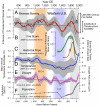Long-term perspective on wildfires in the western USA
- PMID: 22334650
- PMCID: PMC3295264
- DOI: 10.1073/pnas.1112839109
Long-term perspective on wildfires in the western USA
Abstract
Understanding the causes and consequences of wildfires in forests of the western United States requires integrated information about fire, climate changes, and human activity on multiple temporal scales. We use sedimentary charcoal accumulation rates to construct long-term variations in fire during the past 3,000 y in the American West and compare this record to independent fire-history data from historical records and fire scars. There has been a slight decline in burning over the past 3,000 y, with the lowest levels attained during the 20th century and during the Little Ice Age (LIA, ca. 1400-1700 CE [Common Era]). Prominent peaks in forest fires occurred during the Medieval Climate Anomaly (ca. 950-1250 CE) and during the 1800s. Analysis of climate reconstructions beginning from 500 CE and population data show that temperature and drought predict changes in biomass burning up to the late 1800s CE. Since the late 1800s , human activities and the ecological effects of recent high fire activity caused a large, abrupt decline in burning similar to the LIA fire decline. Consequently, there is now a forest "fire deficit" in the western United States attributable to the combined effects of human activities, ecological, and climate changes. Large fires in the late 20th and 21st century fires have begun to address the fire deficit, but it is continuing to grow.
Conflict of interest statement
The authors declare no conflict of interest.
Figures




References
-
- Westerling AL, Hidalgo HG, Cayan DR, Swetnam TW. Warming and earlier spring increase western US forest wildfire activity. Science. 2006;313:940–943. - PubMed
-
- Miller J, Safford H, Crimmins M, Thode A. Quantitative evidence for increasing forest fire severity in the Sierra Nevada and Southern Cascade Mountains, California and Nevada, USA. Ecosystems. 2009;12:16–32.
-
- Littell JS, McKenzie D, Peterson DL, Westerling AL. Climate and wildfire area burned in western U. S. ecoprovinces, 1916-2003. Ecol Appl. 2009;19:1003–1021. doi: 10.1890/07-1183.1. - DOI - PubMed
-
- Trouet V, Taylor AH, Wahl ER, Skinner CN, Stephens SL. Fire-climate interactions in the American West since 1400 CE. Geophys Res Lett. 2010;37:L04702.
-
- Wiedinmyer C, Neff J. Estimates of CO2 from fires in the United States: implications for carbon management. Carbon Balance and Management. 2007;2 doi: 10.1186/1750-0680-1182-1110. - DOI - PMC - PubMed
Publication types
MeSH terms
Substances
LinkOut - more resources
Full Text Sources
Miscellaneous

